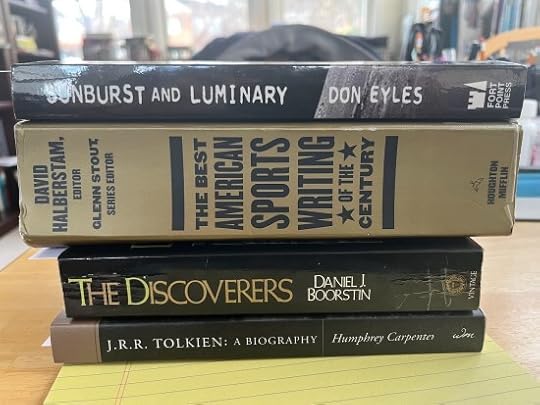Book Stack Management
Software developers using lower-level languages sometimes resort to using a memory region known as a stack. A stack functions on a LIFO or last-in, first-out principle. You push something onto the stack, and then you push something else onto the stack, and you can’t get to the first thing until you pop the top thing off the stack.
Lately, it seems, I manage the books I’m reading in a similar fashion. My “stack” sits on my nightstand. As my attention wanders from one shiny subject to another, books pop onto the stack, and the stack grows. I then must finish the book at the top of the stack (or push another book on) before I go back to an earlier book where I made a mental promise to finish it. My current “stack” stands four books deep.
 The current stack.
The current stack.Here is what happened:
While reading The Hobbit and The Lord of the Rings a few weeks back, I was, in the evenings, also reading a biography of J.R.R. Tolkien by Humphrey Carpenter. So far, so good. Then, at the annual St. Ann Book Fair, I came across an interesting book by Daniel J. Boorstin. It turned out that this book was part of a 3-part series on humanity’s pursuit of knowledge. This is one of many subjects that fascinates me. I very much enjoyed, for instance, Simon Winchester’s books related to this subject: The Professor and the Madman, The Man Who Loved China, The Meaning of Everything, and of course, Knowing What We Know. When I saw this series, I was overcome with a sudden, passionate need to read it.
I pushed the book onto the stack, promising myself I’d come back to the Tolkien biography once I finished this Boorstin book, which I started reading at once.
Except, not long after starting the Boorstin book, I started to flip through another recent addition, The Best American Sports Writing of the Century edited by David Halberstam. I told myself it couldn’t hurt to read the introduction. After reading the introduction, however, I felt compelled to read on. I pushed the book onto the stack, making another promise to finish The Discoverers once I finished the Halberstam book.
The Halberstam book was a kind of balm each evening to days of unsettling news reports. I made it a third of the way into the book when, as fate would have it, in my search for Tindallgrams, I came across a book on the history of the development of the Apollo LM guidance computer: Sunburst and Luminary by Don Eyles. Now, over the course of years, I’ve read just about every book I could find on the Apollo space program: histories, memoirs, biographies, technical books, you name it. This was one I hadn’t come across, and it had the added benefit of dealing with computer code, which is sort of what I deal with during the day. Well, in the grand scheme of things, space exploration trumps baseball, so I pushed Sunburst and Luminary onto the stack and started reading. Which is where things now stand.
A stack, as it turns out, is a good mechanism for one function to call another. The first function is pushed onto the stack, it calls a second function, which is pushed onto the stack. That in turn calls a third, etc. When the final function completes, it pops off the stack, and the previous function continues until it is complete, at which point it pops off the stack. The first function may then call another function that gets pushed onto the stack, so it could be a while before that very first function finally gets popped off the stack.
Which means that when I finish Sunburst and Luminary, I will return to The Best American Sports Writing of the Century. When I finish that, I will return to The Discoverers. Since The Discoverers is the first in a trilogy, there is a chance that The Creators will get pushed onto the stack, followed by The Seekers. When I finish those, I’ll finally get back to the biography of Tolkien. And once that is finished, the stack will be empty.
But the fact is—and this is the wonderful thing about reading—the stack is never empty. The butterfly effect of reading ensures that something is always being pushed on, and if something is popped off, there is always something to go back to.
Did you enjoy this post?
If so, consider subscribing to the blog using the form below or clicking on the button below to follow the blog. And consider telling a friend about it. Already a reader or subscriber to the blog? Thanks for reading!



